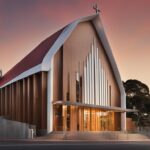The Uniting Church in Australia has a rich history that encompasses its origins, key beliefs, historical significance, denominational splits, leadership and governance, worship practices, and contemporary influence. Understanding the history of this church provides insight into its formation, growth, and impact on the religious landscape of Australia.
Key Takeaways:
- The Uniting Church in Australia was established in 1977 through the merger of the Congregational Union in Australia, the Methodist Church of Australasia, and the Presbyterian Church of Australia.
- The church’s key beliefs include a commitment to the Trinity, the divinity and humanity of Jesus Christ, and the authority of the Scriptures.
- The formation of the Uniting Church in Australia brought together three major Protestant denominations and created a more unified voice for Christianity in the country.
- While the Uniting Church has experienced some denominational splits or schisms, the majority of congregations and members remain united.
- The church operates under a system of interrelated non-hierarchical councils and values consensus decision-making and the participation of all members.
- Worship practices in the Uniting Church encompass a diverse range of styles and formats that reflect its commitment to inclusivity and cultural diversity.
- The Uniting Church in Australia has a contemporary influence on the religious and cultural landscape of the country through its social justice advocacy and community services.
As we delve into the history of the Uniting Church in Australia, we will uncover the origins and founders, explore its key beliefs and doctrines, examine its historical significance, discuss denominational splits, uncover its leadership and governance structure, learn about its worship practices, and assess its contemporary influence on Australian society. This journey will reveal the impact and evolution of the Uniting Church and shed light on its role in shaping the religious fabric of Australia.
Origins and Founders of the Uniting Church in Australia
The Uniting Church in Australia has its roots in the early 20th century when three distinct Protestant denominations made significant contributions to the religious landscape of the country. The Congregational Union in Australia, the Methodist Church of Australasia, and the Presbyterian Church of Australia each had their own unique histories and theological perspectives. However, an increasing emphasis on ecumenism and the desire for unity among Australian Christians ultimately led to the establishment of the Uniting Church in Australia in 1977.
This historic merger was the result of extensive discussions and negotiations between the three denominations. The leaders and members of these churches recognized the need to bear witness to unity in Christ and create a church that would be open to constant reform. The process of establishing the Uniting Church involved extensive consultation, theological reflection, and the drafting of a foundational document known as the Basis of Union. This document outlines the principles, beliefs, and practices that guide the Uniting Church in Australia to this day.
The founders of the Uniting Church believed that the church should reflect the diverse expressions of faith and theologies present within its congregations. This commitment to embracing a broad range of theological perspectives remains a significant aspect of the Uniting Church’s identity. The church continues to value inclusivity, allowing for individual interpretation of scripture within the boundaries set by the Basis of Union.
The establishment of the Uniting Church in Australia has had a lasting impact on the religious landscape of the country. By bringing together three major Protestant denominations, the Uniting Church created a more unified voice for Christianity in Australia. Its formation was not only a significant event in Australian religious history but also served as a model for ecumenical cooperation around the world.
“The Uniting Church embodies the idea that unity in Christ is both possible and desirable,” says Rev. Sarah Johnson, a prominent theologian and member of the Uniting Church. “Its establishment was a bold step towards a more inclusive and diverse expression of Christianity.”
Key Beliefs and Doctrines of the Uniting Church in Australia
The Uniting Church in Australia holds a set of key beliefs and doctrines that guide its practices and shape its identity as a Christian denomination. These beliefs are rooted in the foundations of Christianity and reflect the church’s commitment to faith, unity, and social justice.
One of the central doctrines of the Uniting Church is the belief in the Trinity – the understanding that God exists as three distinct yet inseparable persons: the Father, the Son (Jesus Christ), and the Holy Spirit. This belief in the Trinity highlights the relational aspect of God and informs the church’s understanding of community and fellowship.
The Uniting Church also affirms the divinity and humanity of Jesus Christ. It recognizes that Jesus is both fully God and fully human, and that through his life, death, and resurrection, he offers salvation and reconciliation to humanity. This belief in Jesus as the savior and redeemer shapes the church’s worship, teachings, and mission.
In addition to these core beliefs, the Uniting Church recognizes the authority of the Scriptures and views them as a source of guidance and revelation. The Bible is considered the inspired word of God and is central to the church’s faith and practice. The Uniting Church encourages individual interpretation of the Scriptures, while also emphasizing the importance of studying and engaging with the text in the context of community.
The Basis of Union
The Basis of Union is a foundational document that outlines the key beliefs and principles of the Uniting Church in Australia. It serves as a guide for the church’s life and mission, providing a framework for theological reflection and decision-making. The Basis of Union was developed through a collaborative process involving representatives from the merging denominations, and it reflects the church’s commitment to unity, openness, and diversity.
Alongside these key beliefs and doctrines, the Uniting Church places a strong emphasis on social justice and inclusivity. It actively seeks to address issues of inequality, poverty, and discrimination, and works towards creating a more just and compassionate society. The church’s commitment to social justice is informed by its understanding of the Gospel as a message of liberation and transformation, and it seeks to embody these values in its worship, advocacy, and community engagement.

| Key Beliefs and Doctrines | Description |
|---|---|
| The Trinity | The belief in God as three distinct yet inseparable persons: the Father, the Son (Jesus Christ), and the Holy Spirit. |
| Divinity and Humanity of Jesus Christ | The affirmation that Jesus is both fully God and fully human, offering salvation and reconciliation to humanity. |
| Authority of the Scriptures | The recognition that the Bible is a source of guidance and revelation, considered the inspired word of God. |
| Social Justice and Inclusivity | The commitment to addressing issues of inequality, poverty, and discrimination, and creating a more just and compassionate society. |
The key beliefs and doctrines of the Uniting Church in Australia provide a foundation for the church’s identity and shape its engagement with the world. They guide its worship, inspire its mission, and encourage its members to live out their faith in service to others.
Historical Significance of the Uniting Church in Australia
The Uniting Church in Australia holds great historical significance in the country’s religious landscape. The merger of the Congregational Union in Australia, the Methodist Church of Australasia, and the Presbyterian Church of Australia in 1977 created a unified voice for Christianity in Australia and brought together three major Protestant denominations. This merger was a bold and progressive move, driven by the desire to promote unity in Christ and establish a church that embraces constant reform. The Uniting Church’s formation marked a pivotal moment in Australian religious history, reflecting the shifting dynamics within Christian denominations.
Since its establishment, the Uniting Church in Australia has actively engaged in social justice movements, advocating for Indigenous rights, marriage equality, and addressing issues of poverty and inequality. The church has played a crucial role in shaping the religious and cultural landscape of Australia, demonstrating a commitment to inclusivity, social justice, and community engagement. Through its various initiatives and programs, the Uniting Church continues to leave a lasting impact on Australian society.
Denominational Split or Schisms in the Uniting Church in Australia
The Uniting Church in Australia, like many religious institutions, has experienced denominational splits or schisms throughout its history. These divisions occur when members or congregations have significant disagreements over theological interpretations or other issues. One notable example of a denominational split in the Uniting Church is the formation of the Wesleyan Methodist Church of Australia in the 1990s.
The Wesleyan Methodist Church of Australia was established by individuals and congregations who felt that the Uniting Church was moving away from traditional interpretations of Scripture and theological beliefs. They believed that the Uniting Church’s embrace of more progressive and inclusive views contradicted their understanding of the faith. As a result, they formed a separate denomination that adhered to their preferred theological principles.
While denominational splits can be challenging for any religious institution, the Uniting Church in Australia has remained resilient. The majority of congregations and members have chosen to remain united under the umbrella of the Uniting Church, emphasizing their shared values and commitment to unity in Christ. The Uniting Church continues to thrive and impact the religious landscape of Australia despite these splits, demonstrating its ability to adapt and navigate theological differences while maintaining a sense of community and purpose.
“Denominational splits are not uncommon in religious organizations. The Uniting Church in Australia is no exception. However, what sets the Uniting Church apart is its ability to remain united despite these differences. The formation of the Wesleyan Methodist Church of Australia was a significant event, but it did not diminish the impact and influence of the Uniting Church in Australia.”
Impact and Consequences of Denominational Splits
Denominational splits within the Uniting Church can have various consequences. They often result in the formation of new denominations that offer alternative religious communities for those who feel dissatisfied with the direction of the Uniting Church. These splits can lead to changes in membership numbers, financial implications, and shifts in theological landscapes within the wider religious community.
| Consequences of Denominational Splits | Impact |
|---|---|
| Fragmentation of the religious community | Creates smaller, more ideologically aligned groups |
| Loss of membership | Reduces the size and influence of the Uniting Church |
| Financial implications | Affects the resources and sustainability of both the Uniting Church and the new denominations |
| Changes in theological landscapes | Reflects the diversity of beliefs and interpretations within the wider religious community |
Despite these consequences, the Uniting Church in Australia remains committed to its mission of unity and continues to be a significant religious institution in the country. It strives to find common ground and foster dialogue with those who may have differing theological beliefs, promoting a spirit of understanding and respect.

Overall, the denominational splits within the Uniting Church in Australia are a testament to the complexities of religious diversity and the ongoing pursuit of unity amidst theological differences. While they may present challenges, they also provide opportunities for growth, self-reflection, and a deeper understanding of the diverse range of beliefs held within the religious community.
Leadership and Governance of the Uniting Church in Australia
The Uniting Church in Australia operates under a unique system of interrelated non-hierarchical councils that work together to make decisions and govern the church. This approach reflects the church’s commitment to inclusivity, collaboration, and the participation of all members.
The Uniting Church is governed by three levels of councils: the congregation, the presbytery, and the synod. Each level has its own responsibilities and powers but ultimately works together in a collaborative manner. The leadership within the Uniting Church is shared among both ordained ministers and laypeople, highlighting the church’s belief in the priesthood of all believers and the importance of lay participation in decision-making processes.

Consensus decision-making is a fundamental aspect of the Uniting Church’s governance structure. This process involves seeking the input and agreement of all council members, allowing for a more inclusive and democratic decision-making process. It also reflects the church’s commitment to discerning the will of God as a collective body rather than relying solely on individual authority.
Table: Council Structure of the Uniting Church in Australia
| Council Level | Responsibilities | Powers |
|---|---|---|
| Congregation | Worship, pastoral care, and outreach within the local community | Electing representatives to the presbytery and synod |
| Presbytery | Supporting and guiding congregations within its designated region | Approving the placement and transfer of ministers |
| Synod | Setting church policy, overseeing mission and ministry, handling administration and finances | Making and amending regulations, issuing statements on social justice and theological matters |
“The Uniting Church’s governance structure ensures that decisions are made in a collaborative and inclusive manner, reflecting our commitment to the priesthood of all believers and shared leadership.”
The Uniting Church in Australia’s leadership and governance structure enables the active participation of all members and promotes a sense of ownership and responsibility within the church. This collaborative approach has helped the Uniting Church navigate challenges, adapt to changing circumstances, and remain a vibrant and relevant presence in the Australian religious landscape.
Worship Practices of the Uniting Church in Australia
The Uniting Church in Australia embraces a diverse range of worship practices that reflect its commitment to inclusivity and the participation of all members. Worship services in the Uniting Church often include elements of liturgy, music, prayer, and biblical teaching. There is flexibility in the style and format of worship, allowing for different expressions of faith and cultural traditions. The sacraments of baptism and communion are also central to the worship practices of the Uniting Church.
Music plays a significant role in Uniting Church worship. Hymns are commonly sung, accompanied by organ or piano. Contemporary worship songs and choruses are also integrated into services, bringing a mix of traditional and modern worship styles. This diversity in musical expression fosters an inclusive environment where members can worship in ways that resonate with their individual spirituality.
Prayer is another integral component of worship in the Uniting Church. Prayers of confession, thanksgiving, intercession, and lament are offered during services, inviting congregants to engage with God on a personal and communal level. The use of liturgy and responsive readings creates a sense of unity and participation among worshipers, while allowing for individual reflection and response to God’s presence.
“Worship is a time of encounter with the living God, where hearts are opened, minds are engaged, and spirits are renewed. It is a sacred space where we gather as a community to express our love, gratitude, and adoration to God.”
The Uniting Church also recognizes the importance of biblical teaching in worship. Sermons and teachings draw from the Scriptures, providing guidance, inspiration, and challenge to the congregation. The interpretation and application of biblical texts often reflect the Uniting Church’s commitment to social justice, inclusivity, and the transformative power of faith.
Table: Comparison of Worship Practices
| Denomination | Worship Style | Music | Prayer | Biblical Teaching |
|---|---|---|---|---|
| Uniting Church in Australia | Diverse | Traditional hymns and contemporary worship songs | Confession, thanksgiving, intercession, lament | Draws from Scriptures with a focus on social justice |
| Anglican Church | Traditional | Hymns and choral music | Collects, intercessions, and liturgical prayers | Expository sermons |
| Baptist Church | Vibrant | Contemporary worship songs | Informal prayers, testimonies | Expository sermons |
It is important to note that worship practices can vary within denominations, and individual congregations may have their own unique expressions of worship. The Uniting Church in Australia celebrates this diversity and encourages congregations to create worship experiences that are meaningful and relevant to their local context.

Contemporary Influence of the Uniting Church in Australia
The Uniting Church in Australia continues to have a significant influence on the religious and cultural landscape of the country. With its strong commitment to social justice and inclusivity, the Uniting Church plays an active role in advocating for various causes and addressing pressing issues.
One area in which the Uniting Church has made an impact is in advocating for Indigenous rights. The church has been vocal in supporting the rights of Indigenous Australians, including land rights, self-determination, and reconciliation. It has actively participated in campaigns and initiatives aimed at addressing the historical injustices faced by Indigenous communities.
In addition, the Uniting Church has been at the forefront of the movement for marriage equality in Australia. The church has consistently supported the rights of same-sex couples to marry and has actively campaigned for the recognition of LGBTQ+ rights. Its inclusive approach to marriage and relationships has resonated with many individuals and communities, making a significant impact on the national conversation.
“The Uniting Church’s commitment to social justice and inclusivity is a powerful force in Australia. It is a voice that not only speaks out against injustice but actively works towards creating a more equitable and compassionate society.”
Furthermore, the Uniting Church has been involved in addressing issues of poverty and inequality through its various community service programs. These programs provide support and assistance to vulnerable individuals and groups, including aged care services, disability support, and welfare programs. The church’s commitment to serving those in need is rooted in its belief in the inherent dignity and worth of every person.
As the Uniting Church in Australia continues to embrace its core values and engage with the pressing issues of our time, it remains a relevant and influential presence in the Australian religious landscape. Its commitment to social justice, inclusivity, and community service ensures that it continues to make a positive impact on the lives of many individuals and communities.

Conclusion
The history of the Uniting Church in Australia is a testament to the ongoing journey of faith, unity, and commitment to social justice. Formed in 1977 through the merger of the Congregational Union in Australia, the Methodist Church of Australasia, and the Presbyterian Church of Australia, the Uniting Church has played a significant role in the religious landscape of Australia.
From its origins to its contemporary influence, the Uniting Church has made a lasting impact. It has actively participated in social justice movements, advocated for Indigenous rights, supported marriage equality, and addressed issues of poverty and inequality. The church’s commitment to inclusivity and social justice resonates with many individuals and communities in Australia.
Operating under a non-hierarchical system of interrelated councils, the Uniting Church ensures that leadership and governance are shared among both ordained ministers and laypeople. This collaborative approach reflects the church’s commitment to inclusivity and the participation of all members.
As the Uniting Church in Australia continues to evolve and adapt, it remains a vibrant and diverse community of believers, united in their common purpose and shared values. Its rich history, key beliefs and doctrines, historical significance, denominational splits, leadership and governance, worship practices, and contemporary influence all contribute to its unique place in the religious and cultural fabric of Australia.
FAQ
What is the history of the Uniting Church in Australia?
The Uniting Church in Australia was formed in 1977 as a result of the merger between the Congregational Union in Australia, the Methodist Church of Australasia, and the Presbyterian Church of Australia.
What are the key beliefs and doctrines of the Uniting Church in Australia?
The Uniting Church in Australia is committed to the fundamental beliefs of Christianity, including the belief in the Trinity, the divinity and humanity of Jesus Christ, and the authority of the Scriptures.
What is the significance of the Uniting Church in Australia in Australian religious history?
The formation of the Uniting Church in Australia brought together three major Protestant denominations and created a more unified voice for Christianity in the country, impacting the religious and cultural landscape.
Have there been any schisms within the Uniting Church in Australia?
Yes, there have been schisms within the Uniting Church in Australia, but the majority of congregations and members remain united under the umbrella of the Uniting Church.
How is the Uniting Church in Australia led and governed?
The Uniting Church in Australia operates under a system of interrelated non-hierarchical councils, with leadership shared among ordained ministers and laypeople.
What are the worship practices of the Uniting Church in Australia?
Worship services in the Uniting Church often include elements of liturgy, music, prayer, and biblical teaching, with flexibility in style and format to accommodate different expressions of faith and cultural traditions.
What is the contemporary influence of the Uniting Church in Australia?
The Uniting Church in Australia is actively involved in social justice movements, advocacy work, and providing community services, reflecting its commitment to inclusivity and social justice.
















